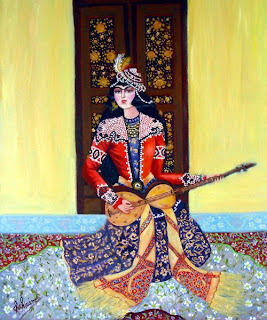 Region traditionally known as Persia is now called Iran. The term ancient Persia is used to refer to the period before the advent of Islam in the 7th century A.D. The high plateau of Iran has seen the development of many cultures, all of which have added distinctive features to the many styles of Persian art and architecture.
Region traditionally known as Persia is now called Iran. The term ancient Persia is used to refer to the period before the advent of Islam in the 7th century A.D. The high plateau of Iran has seen the development of many cultures, all of which have added distinctive features to the many styles of Persian art and architecture.
Early works
Although earlier civilizations are known, the first archaelogical finds of artistic importance are the superb ceramics from Susa and Persepolis (c.3500 B.C.). The choice of biological subjects, simplified into patterns, may be called the formative principle of Persian art. Much of 4th-millennium Iranian art is strongly influenced by that of Mesopotamia. The 3d-millennium art of Elam, found at Sialk and Susa, also follows Mesopotamian styles, and this trend is continued in the less well-known Elam and Urartu art of the 2d millennium.
Beginning at the end of the 2nd millennium to the middle of the 1st millennium a great florescence of bronze casting occurred along the southern Caspian mountain zone and in mountainous Lorestan. Probably dated 1200-700 B.C., harness trappings, horse bits, axes, and votive objects were made in large quantities and reflected a complex animal style created by combining parts of animals and fantastic creatures in various forms.
Achaemenian period (550-330 B.C.)
A unified style emerges. Luxurious works of decorative art were produced. The Achaemenids evolved a monumental style in which relief sculpture is used as an adjunct to massive architectural complexes. Remains of great palaces reveal plans that characteristically show great columned audience halls. The style as a whole and the feeling for space and scale are distinctive.
In the sculpture is shown ordered clarity and simplicity. Heraldic stylization is subtly combined with effects of realism. Typical are the low stone reliefs and friezes executed in molded and enameled brick, a technique of Babylonian-Assyrian origin. The great care lavished on every stone detail is also found in the fine gold and silver rhytons (drinking horns), bowls, jewelry, and other objects produced by this culture.
After the death of Alexander the Great (323 B.C.), there was turmoil in Iran until the rise of the Parthians (c.250 B.C.). Theirs is essentially a crude art, synthesizing Hellenistic motifs with Iranian forms.
Sassanian Period (A.D. 224 - 651)
Of far greater artistic importance is the the Sassanian art. Adapting and expanding previous styles and techniques, they rebuilt the Parthian capital at Ctesiphon. There a great palace with a huge barrel vault was constructed of rubble and brick. Sassanid architecture is decorated with carved stone or stucco reliefs and makes use of colorful stone mosaics.
Sassanian metalwork was highly developed, the most usual objects being shallow silver cups and large bronze ewers, engraved and worked in repoussé. The commonest themes were court scenes, hunters, animals, birds, and stylized plants. The largest collection of these vessels is in the Hermitage Museum, Saint Petersburg. The Sassanids recorded their triumphs on immense outdoor rock reliefs scattered throughout Iran, often using the same sites that the Achaemenids had covered with reliefs and inscriptions.
No comments:
Post a Comment